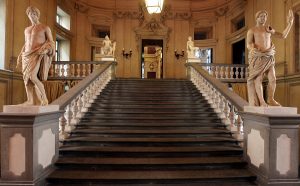Antiques Show: History, Modernity & Elegance

Until October 1: INTERNATIONAL BIENNAL ANTIQUES FAIR (Biennale Internazionale di Antiquariato di Firenze). Palazzo Corsini, Via del Parione 11, Florence. Open from 10:30 am to 8 pm daily, except on September 28, when it will close at 7 pm. Admission: €15.
Readers will be given a 30% discount at the Antiques Biennale show (€10 instead of €15) at Palazzo Corsini and a 20% discount at the new exhibition Il Cinquecento a Firenze at Palazzo Strozzi (€9 instead of €12) by printing the Magenta Smart Card or show it on your phone at the ticket office. Showing an AILO membership card is valid for the discount as well. The Smart Card may be accessed at https://www.magentaflorence.com/smart-card/
For its 30th anniversary, the International Biennial Antiques Fair of Florence will showcase some of the world’s most popular works of modern art alongside the ancient masterpieces that it typically celebrates.
The edition will highlight the unique relationship that exists in Florence between ancient and contemporary. The Biennale has expanded its date constraints to include contemporary art created as recently as the 1980s for the first time ever.
According to the Secretary General of the Biennale, Fabrizio Moretti, the new layout “is a mix of modernity and elegance.” Moretti has explained that his vision for this year’s show involves “a mingling of works of very different ages, from archaeology to contemporary, through all the great moments in the history of universal art.”
Exhibitors, some of the most renowned antique dealers in the world, are unveiling paintings that span the centuries, from medieval fondo oro, Luca della Robbia and Lo Spagnoletto (Jusepe de Ribera, 1491- 1652) to portraits by Giovanni Boldini, as well as the rare works of Pablo Picasso, Miró, Carlo Carrà, Lucio Fontana, Alberto Burri and Arman. Notable Tuscan artists include Galileo Chini. There is even a historic and elaborate 3-meter (10 ft.) high Nativity scene constructed by Neapolitan craftsmen.
Held in its traditional venue of Palazzo Corsini, a famous artist and fresh face has contributed to this year’s setup. Entrusted with creating a new layout, Matteo Corvino is a Venetian interior designer and set designer.
Corvino’s carefully constructed plan includes the installation of a glass ceiling for Palazzo Corsini’s central pathway and the reconstruction of a rooftop garden lined with boxwoods located on the terrace. Thanks to the contrast created, these modern additions allowed Corvino to achieve his goal of providing visitors to the show with greater visibility of the palace’s 17th-century architecture.
Another highly anticipated modern art project is an art installation by Swiss artist Urs Fischer in Piazza Signoria. His work, which includes drawings, collages, and room-size installations, shows the influences of movements such as Neo-Dada, Lost Art, and Situationist International.
At Palazzo Corsini, a final special exhibition offering a contrast between ancient and modern is “A Meeting Between Late Gothicism and the Contemporary: Pietro di Chellino and Pietro Annigoni.” Treasures from Florence’s Cassa di Risparmio Foundation’s private collection will be exhibited as part of this retrospective, which is another masterful artistic combination of the old and new.
Regarding the more traditional antique pieces that have characterized the fair, visitors of this year’s fair can expect to view works checked for authenticity by an authoritative International Scientific Committee. Exhibits include a 16th-century sculpture by Giovanni Angelo del Maino of St. John the Evangelist (Meheringer Benappi) and a marble sculpture by Battista Lorenzi depicting Virtue defeating Vice (Giovanni Pratesi).
Additional pieces featured are constructed from unique materials. Longari Arte Milano will contribute Madonna Morgan, a terra cotta of the Virgin and Child by Mino da Fiesole. The Carlo Virgilio Gallery will present a Carrara marble statue of the mythological Greek shepherd Endymion sculpted by Virgilio Aristodemo Costoli.
Furnishings include a pair of Venetian sofas from Piva & C. Another notable item is a pair of 18th-century nightstands displayed by Alessandra di Castro.
A number of exceptional paintings will be showcased. They include a battle series between the Greeks and Romans by Livio Mehus (Lullo Pampoulides) and a portrayal of the flight to Egypt by Orazio Samacchini, originally in the Giustiniani Collection and later part of the Imperial Hohenzollern Collection.
Other outstanding exhibits comprise John Paul Castelli’s Lo Spadino, a still life of the seasons. Another featured painting is Russian artist Karl Brullov’s masterful representation of Russian noble Anatoly Demidov.
A work by renowned hyperrealist painter Cagnaccio di San Pietro is from the 20th century. The painting, which will be shown by Damiano Lapiccirella, is entitled The Letter of 1925, and shows two women immersed in light intently reading written correspondence.
Another 20th-century piece that will be featured is Pilino Nomellini’s large oil painting of blossoming flowers, titled Florentine Spring. The canvas, which has not been accessible to the public since 1922, was sourced from a private German collection (Paolo Antonacci Antiques).
Finally, it is worth noting that visitors to this year’s Biennial will receive a discount for the show “The Cinquecento in Florence: Between Michelangelo, Pontormo, and Giambologna,” paying €9 as opposed to €12. Visitors to the exhibition, which is held in Palazzo Strozzi, will also be able to enter the Antiques Show at a reduced price of €10.
Overall, from sculpture to furnishings to paintings, the fair contains pieces that any antiques lover will certainly enjoy viewing. It is clear that additions from Corvino, Fischer, and the Cassa di Risparmio Foundation will bring a modern twist to the traditional elegance that has characterized the Biennale in past years. (margaux glovier/additional reporting by rosanna cirigliano)
